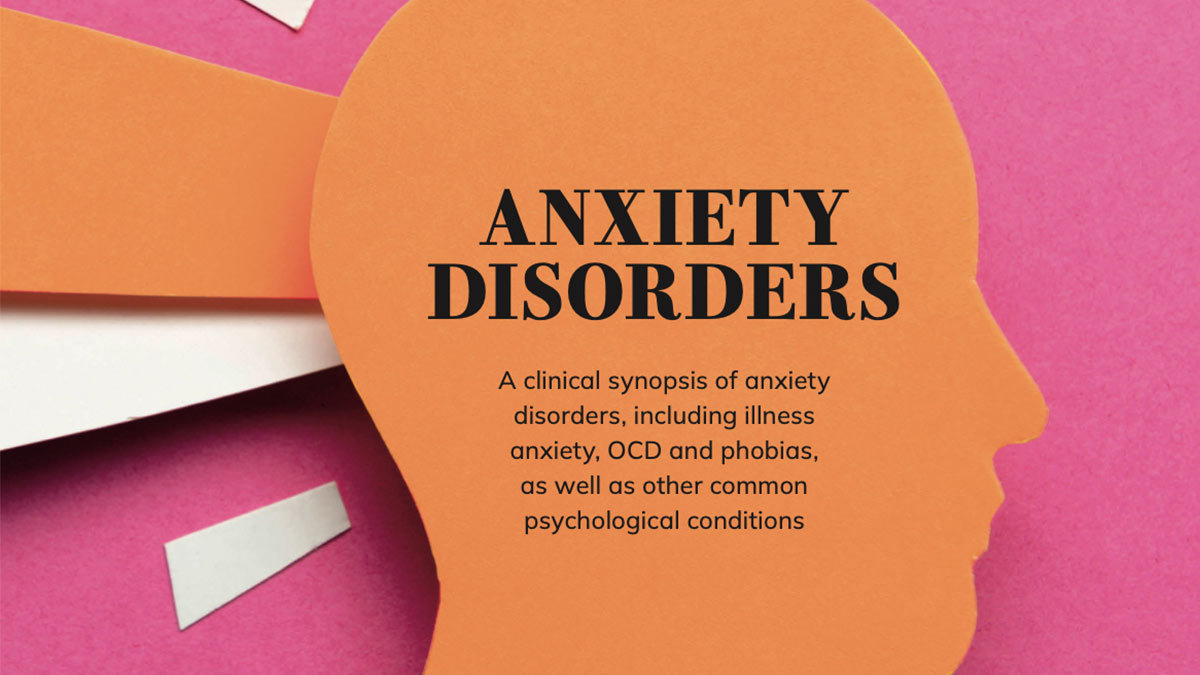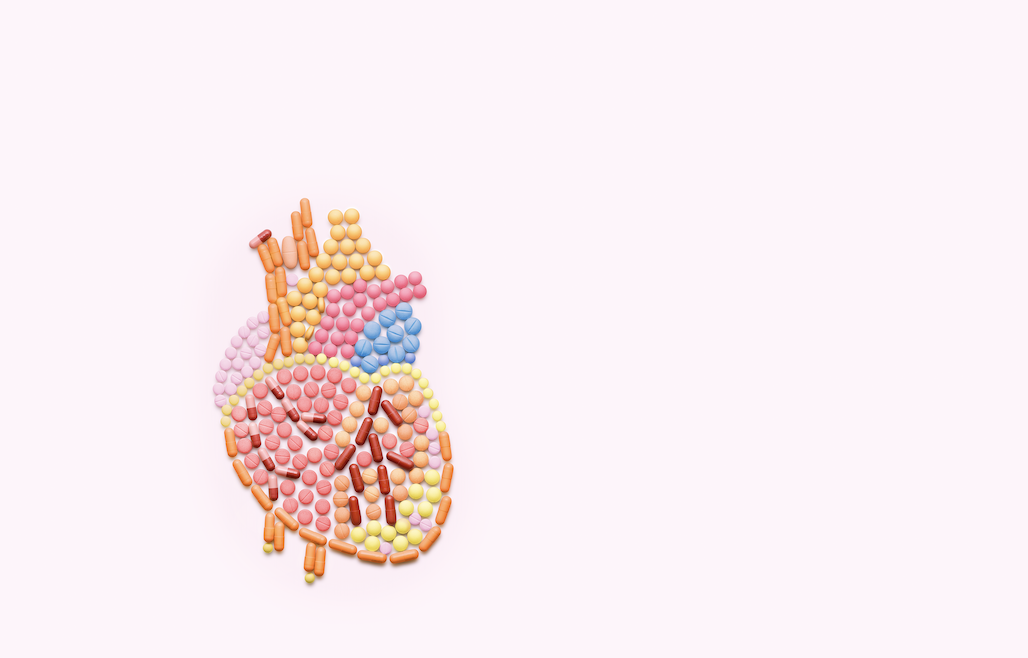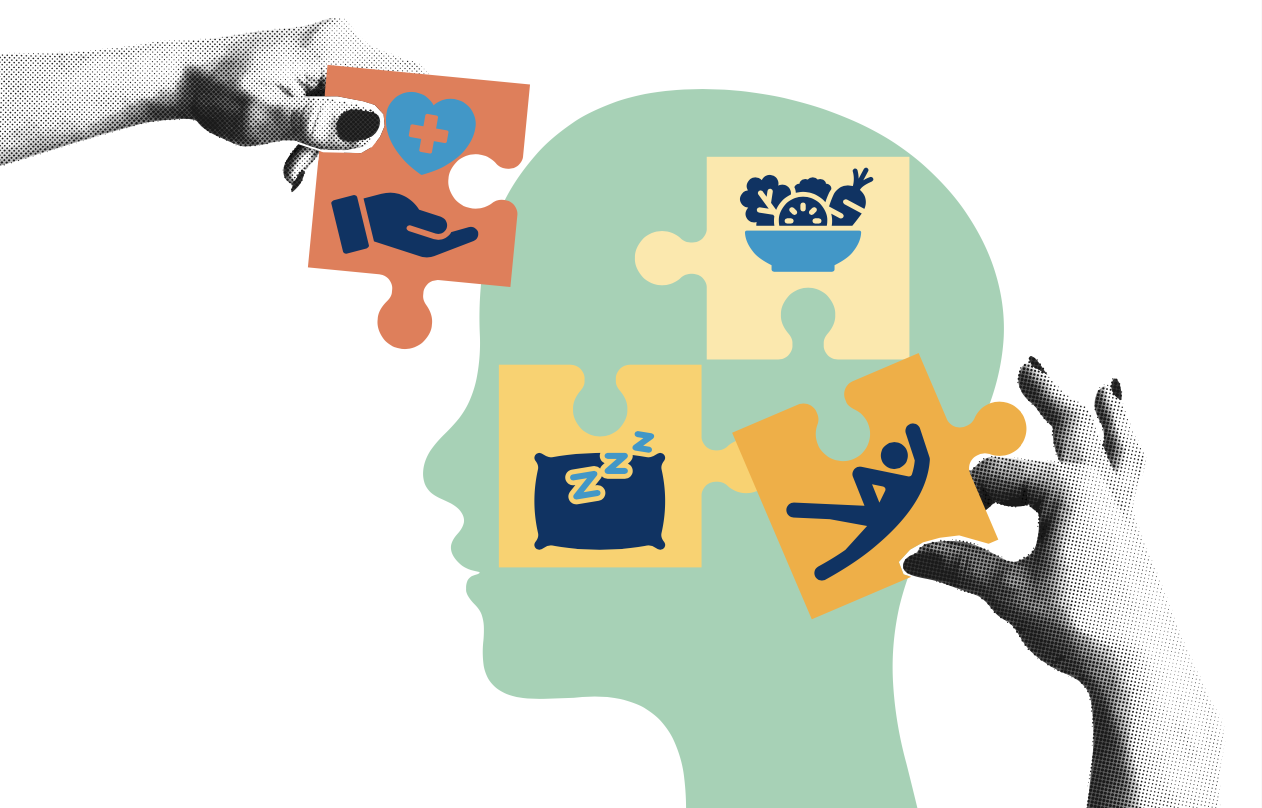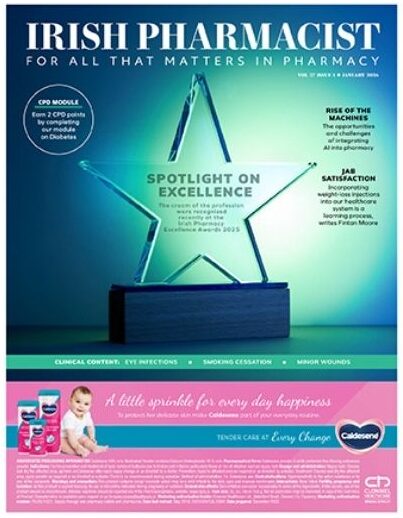Introduction
Anxiety disorders are common, but people with these disorders are frequently not offered adequate support and treatment. Multiple studies have demonstrated a limited detection and treatment of anxiety disorders in primary care. This has multiple contributing factors: Many patients find it difficult to talk about emotional symptoms, and many clinicians find it difficult to raise concerns about possible psychological distress.1 There may be concerns over the ‘medicalisation’ of anxiety or shyness; however, in general, studies show a high level of unmet need and low levels of inappropriate prescribing.1 Although anxiety disorders can exist in isolation, they more commonly coexist with other anxiety disorders and depression.2 Where possible, the treatment goal should be complete remission, leading to better functioning, and a reduced likelihood of relapse into what is usually a chronic or remitting course. For people who have a comorbid depressive or other anxiety disorder, the primary disorder should be treated first, ie, the one that is more severe, the treatment of which is more likely to improve overall functioning.
Epidemiological studies indicate that anxiety disorders have a prevalence of 14 per cent in the general population over a one-year period; and a lifetime prevalence of 21 per cent (Table 1). The prevalence and incidence for specific anxiety disorders varies; eg, phobias are more common in women while panic disorder occurs nearly equally in men and women in middle age. Overall, there is a 2:1 female to male ratio across all ages.
Table 1. Twelve-month prevalence of anxiety disorders within the European Union.1
| Diagnosis | Estimate (per cent) | Number affected (millions) |
| Anxiety disorders (all) | 14 | 61.5 |
| Panic disorder | 1.8 | 7.9 |
| Agoraphobia | 2 | 8.8 |
| Social anxiety disorder | 2.3 | 10.1 |
| Specific phobias | 6.4 | 22.7 |
| Generalised anxiety disorder | 1.7-3.4 | 8.9 |
| Obsessive-compulsive disorder | 0.7 | 2.9 |
| Post-traumatic stress disorder | 1.1-2.9 | 7.7 |
High levels of comorbidity are seen between anxiety disorders and schizophrenia, substance abuse, and physical illness, as well as depression. The identification of a seemingly more important condition can lead to lower treatment levels for the coexisting anxiety disorder. Research has indicated that those with anxiety or mixed anxiety/depression are less likely to be offered treatment compared to those with depression alone. When working with people with anxiety disorders (as with many types of illness), it is especially important to build a relationship and work with the person in an open, engaging, and non-judgemental manner. Treatment options with the clinician should be explored collaboratively, ensuring confidentiality, privacy, and dignity.2
Anxiety disorders and related disorders
The different types of anxiety disorders are described below. The Diagnostic and Statistical Manual of Mental Disorder, 5th edition (DSM-5), no longer includes obsessive compulsive disorder or post-traumatic stress disorder among anxiety disorders. However, they are still closely related.
Generalised Anxiety Disorder (GAD)
- Excessive and inappropriate persistent worrying (more than a few months).
- Physical anxiety symptoms and key psychological symptoms present (restlessness, fatigue, difficulty concentrating, irritability, muscle tension, disturbed sleep).
Panic disorder (PD, with or without agoraphobia)
- Unexpected surges of severe anxiety, with varying degrees of anticipatory anxiety between attacks.
- Panic attacks: Periods of intense fear/discomfort, accompanied by physical/psychological anxiety symptoms, typically reaching a peak within 10 minutes, and lasting up to 45 minutes.
Phobias are more common in women, while panic disorder occurs nearly equally in men and women in middle age
Social phobia (social anxiety disorder)
- Marked, persistent, and unreasonable fear of being observed or evaluated negatively by other people, in social or performance situations.
- Associated with physical and/or psychological anxiety symptoms.
Specific phobia
- Excessive or unreasonable fear of (and restricted to) single people, animals, objects, or situations, eg, dentists, spiders, lifts, or flying.
Separation anxiety disorder
- Fear of anxiety concerning separation from those to whom a person is attached, eg, excessive distress when experiencing/anticipating leaving home, or worries about potential harms to attachment figures or events that might result in separation.
Post-traumatic stress disorder
- History of exposure to trauma (actual, or threatened, death, serious injury, threats to physical integrity of self or others) with a response of intense fear, helplessness, or horror.
- Later development of intrusive symptoms such as recollections, flashbacks or dreams, avoidance symptoms, negative alterations in cognitions and mood, and hyperarousal (disturbed sleep, hypervigilance).
Obsessive-compulsive disorder
- Recurrent obsessive ruminations, images, or impulses, and/or recurrent physical/mental rituals which are distressing, time-consuming, and interfere with social and occupational function.
- Common obsessions include those relating to contamination, accidents, and religious or sexual matters. Common rituals include washing, checking, cleaning, counting, and touching.
Illness anxiety disorder
- Excessive/disproportionate preoccupation with having or developing a serious illness with excessive health-related behaviours.
Randomised control trials (RCTs) of anxiety disorders often show a high placebo response to treatment. This suggests that the non-specific effects of assessment and monitoring can help with symptom improvement.
Pharmacological treatments
When pharmacological treatment is initiated, we need to be mindful of the fact that not only is treatment response not immediate (it may take a week or more), but that transient worsening of symptoms may occur.1,2 People under 30 should be made aware of the association of selective serotonin reuptake inhibitors (SSRIs) and serotonin norepinephrine reuptake inhibitors (SNRIs) and an increased risk of suicidal thinking and self-harm in a minority of people under 30.2 They should be closely monitored for the first month and seen again within the first week. Some pharmacological treatments recommended by the NICE guidelines may not be licensed specifically for a certain type of anxiety disorder – however, the lack of licensing does not mean that there is no evidence for its use in the indication. Conversely, when one member of a drug class has proven to be effective, we should not assume this means all drugs in the class are equally effective.1
People aged under 30 should be
made aware of the association between SSRIs and SNRIs
SSRIs are considered the first-line treatment for anxiety disorders,1 with broad efficacy and generally good tolerability, specifically sertraline.2 Some patients experience adverse effects including increased nervousness, insomnia, nausea, and sexual dysfunction. If stopped suddenly, even when slowly tapered, SSRIs are often associated with a ‘discontinuation syndrome’ which includes symptoms like dizziness, insomnia, and flu-like symptoms.1 If sertraline is ineffective, an alternative SSRI or SNRI should be offered,2 taking into account the likelihood of a discontinuation syndrome (especially paroxetine and venlafaxine), the side-effect profile, interactions, and risk of suicide/overdose toxicity (especially with venlafaxine). There are multiple resources that offer information about antidepressant switching including from the NHS.3
Increased risk of gastrointestinal (GI) bleed with SSRIs should be kept in mind with susceptible patients, eg, those taking other drugs that can damage the GI mucosa or interfere with clotting, and older people.
The SNRIs duloxetine and venlafaxine are effective for anxiety disorders. Both of these drugs have been associated with discontinuation symptoms after abrupt withdrawal. Reviews suggest that these are not tolerated as well as SSRIs side-effect wise, although the tolerability profiles of both classes in anxiety disorders is not considered to be fully established. Cases of hypertension have been seen with venlafaxine, especially with higher doses. Duloxetine is not recommended in patients with any hepatic disorders, although pharmacoepidemiological studies have not found any evidence for concern.
Tricyclic antidepressants (TCAs) are effective in treating some anxiety disorders, however, they are associated with higher rates of adverse effects compared to either SSRIs or SNRIs. Because of this, they are usually reserved for patients who do not tolerate or respond to SSRI/SNRIs. Notably, TCAs should be avoided if there is any potential suicide risk, because of the potentially fatal toxicity after overdose. Like the other classes of antidepressants, withdrawal of TCAs is associated with a discontinuation syndrome.
Agomelatine is effective for GAD, with lower rates of sexual dysfunction reported than for SSRIs or SNRIs, and discontinuation symptoms less likely. Increased levels of hepatic enzymes occur in over 1 per cent of patients, and as a result monitoring is required in the early months of treatment.
Evidence for mirtazapine in anxiety disorders is mixed, although it may be a useful option in patients who have depression, and treatment-related sexual dysfunction with SSRIs/SNRIs.
Some benzodiazepines(BZDs) are effective in anxiety disorders, but are sedating, can induce cognitive impairment, and are associated with tolerance and dependence.1 A BZD is not recommended except for very short-term use during crises.2
Pregabalin is effective in treating GAD and social anxiety disorder. Drowsiness and dizziness are common side effects but it may be better tolerated than other medications. Long-term treatment is associated with weight gain in about 20 per cent of people. Discontinuation symptoms are reported, with the potential for developing tolerance and abuse. Patients should be advised to take it for at least a year due to the high risk of relapse if discontinued sooner.
The specific NICE guidance available for the treatment of GAD and PD2 does not recommend the use of antipsychotics in primary care. A stepwise approach to treatment is recommended (Table 2).
Table 2. The stepped-care model for generalised anxiety disorder (GAD).2
| Focus of intervention | Nature of intervention |
| Step 4: Complex, treatment-refractory GAD, marked functional impairment like self-neglect or self-harm | Highly specialist treatment (eg, complex drug/psychological treatment regimens), input from multidisciplinary teams, crisis services, day hospitals, inpatient care |
| Step 3: GAD with inadequate response to step 2 interventions, marked functional impairment | Choice of high intensity psychological intervention (CBT/applied relaxation), or a drug treatment |
| Step 2: Diagnosed GAD that has not improved after education and active monitoring in primary care | Low intensity psychological interventions: Individual non-facilitated self-help, individual guided self-help, and psychoeducational groups* |
| Step 1: All known and suspected GAD cases | Identification and assessment, education about GAD and its treatment options, active monitoring |
*Individual non-facilitated self-help involves written or electronic self-help materials. Individual guided self-help is based on CBT principles, and includes written or electronic materials suitable for the patient, supported by a trained practitioner who facilitates. Psychoeducational groups should also be based on CBT principles and be interactive.
Substance abuse can be a complication of GAD. Harmful and dependent substance abuse should be addressed and treated first because this itself may lead to significant improvements in GAD.1
Non-pharmacological treatment
Exposure therapy, applied relaxation, and cognitive behaviour therapy (CBT) have consistent evidence of efficacy in treatment of anxiety disorders.1,2 Psychological approaches to treating anxiety have similar levels of efficacy to pharmacological. Treatment with medication can enhance the efficacy of CBT interventions. As with pharmacological treatments, response to psychological treatments may not be immediate, and a transient worsening of symptoms can occur. Extended durations of treatment are often needed to maintain an initial response.
Although both sertraline and CBT are effective in the treatment of GAD, their relative efficacy has not been assessed. RCT data investigating this would clarify how to prioritise stepwise treatment in anxiety disorders.
References
- Baldwin, DS, Anderson, IM, Nutt, DJ, Allgulander, C, Bandelow, B, den Boer, JA, … & Wittchen, HU (2014). Evidence-based pharmacological treatment of anxiety disorders, post-traumatic stress disorder, and obsessive-compulsive disorder: A revision of the 2005 guidelines from the British Association for Psychopharmacology. Journal of Psychopharmacology, 28(5), 403-439.
- National Institute for Health and Care Excellence. (2020). Generalised Anxiety Disorder and Panic Disorder in Adults: Management [CG113]. Available at: www.nice.org.uk/guidance/cg113/resources/generalised-anxiety-disorder-and-panic-disorder-in-adults-management-pdf-35109387756997.
Specialist Pharmacy Services NHS. (2024). SSRIs to other antidepressants. Available at: www.sps.nhs.uk/articles/ssris-to-other-antidepressants-switching-in-adults







